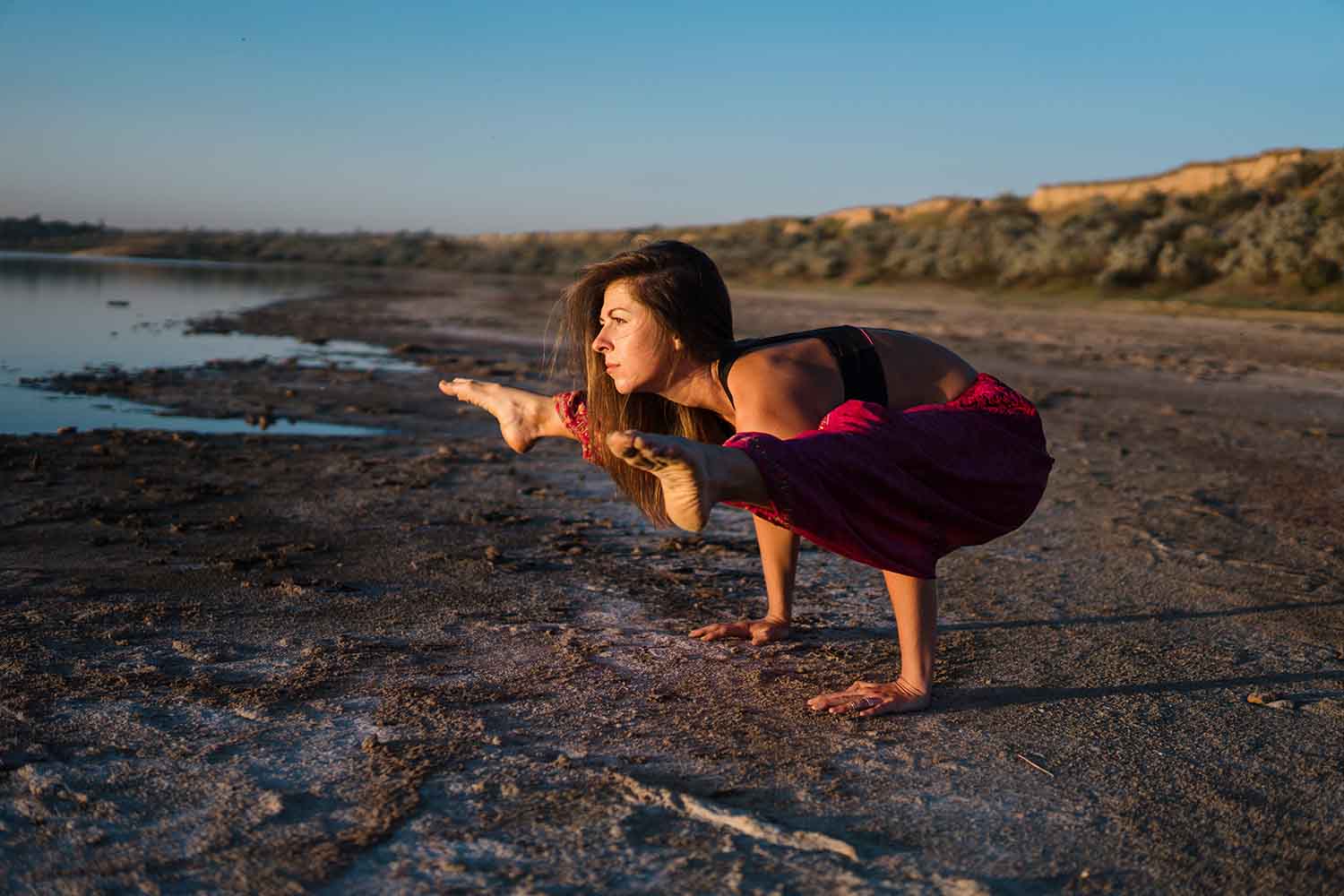Firefly Pose in yoga, or Tittibhasana in Sanskrit, is a challenging arm balance that builds core strength, flexibility, and mental focus. This pose requires a combination of arm strength, hip flexibility, and balance, making it a rewarding addition to any advanced yoga practice.
Other Names for Firefly Yoga Pose
- Tittibhasana
- Flying Firefly Pose
How to Do Firefly Pose in Yoga
To get into Firefly Pose, follow these steps carefully:
- Start in a Forward Fold: Stand at the front of your mat with your feet hip-width apart. Bend forward from your hips, allowing your hands to touch the ground.
- Prep the Legs: Bend your knees slightly and slide your arms underneath your legs, bringing your hands behind your ankles. Your shoulders should tuck behind your knees.
- Lift the Hips: Plant your hands firmly on the ground, shoulder-width apart, and begin to lift your hips while straightening your legs. At this point, your torso should be parallel to the floor.
- Engage the Core: Shift your weight into your hands and press down through your palms. Start to extend your legs out to the sides, keeping them as straight as possible. Engage your core and lift through your chest to maintain balance.
- Hold and Balance: As you extend the legs and lift your hips higher, keep your gaze forward. Hold the pose for 5–10 breaths, maintaining strength in your arms and core.
Key Alignment Points:
- Press through the palms to avoid collapsing into the wrists.
- Keep the chest lifted to counterbalance the legs.
- Engage the core throughout the pose to maintain stability.
Variations of Firefly Pose
- Bent-Knee Firefly: If you’re still working on flexibility, keep your knees bent instead of fully extending your legs.
- One-Legged Firefly: Practice lifting one leg at a time to build strength and balance gradually.
- Flying Firefly: For advanced practitioners, practice transitioning into other arm balances such as Crow Pose or flying splits from Firefly Pose.
Modifications for Firefly Pose in Yoga
- Use a Block: Place a yoga block under your hips for added support and stability as you get used to the balancing aspect of the pose.
- Keep Knees Bent: If hamstring flexibility is limiting, keep the knees slightly bent while focusing on building arm strength.
- Practice L-Sits: To develop the necessary core and arm strength, practice L-Sits on blocks before progressing to Firefly Pose.
Contraindications for Firefly Pose in Yoga
Exercise caution or avoid Firefly Pose if you experience any of the following:
- Wrist Injuries: The weight on the wrists can aggravate injuries. Consider strengthening the wrists first or using wrist support.
- Lower Back Pain: Avoid this pose if you have lower back issues, as the forward fold and lift can put pressure on the spine.
- Tight Hamstrings: Practice gentle hamstring stretches to avoid straining the muscles before attempting Firefly.
Tips to Improve Firefly Pose in Your Practice
- Engage the Core: Your core muscles are essential for lifting and holding your legs in Firefly. Work on core strengthening poses like Boat Pose or Plank Pose to prepare.
- Stretch the Hamstrings: Since flexibility is key, practice hamstring stretches such as Forward Fold or Pyramid Pose to open the back of your legs and prepare for the full extension in Firefly.
- Use Props: Blocks can help elevate your hips and make the pose more accessible as you build strength and flexibility. Over time, reduce your reliance on props as you progress.
- Practice Arm Balances: Poses like Crow Pose help build the arm strength and balance required for Firefly. These preparatory poses also help you get used to shifting weight onto your hands.
- Breathe Deeply: When balancing in Firefly, keep your breath steady to maintain focus and reduce tension in your body. Deep, controlled breaths will help keep you grounded.
- Focus on Alignment: Start by aligning your hands and arms properly. Make sure to press firmly into the ground and lift your hips using your core to stabilize your pose.
What Muscles Does Firefly Pose Work?
Firefly Pose primarily works these muscles:
- Core Muscles (Abdominals and Obliques): Engaging the core is essential for lifting the legs and holding the pose.
- Shoulders and Arms (Deltoids, Triceps): These muscles stabilize your upper body as you balance.
- Hamstrings: Stretching the legs straight requires hamstring flexibility and strength.
- Hip Flexors: Lifting and extending the legs outward engages the hip flexors.
- Wrists and Forearms: Holding your body weight on your hands strengthens the wrists and forearms over time.

Mental and Emotional Benefits of Firefly Pose in Yoga
- Builds Confidence: Mastering this challenging pose can boost your self-confidence as it requires a blend of strength, focus, and balance.
- Improves Focus: Arm balances like Firefly demand concentration. Practicing this pose encourages mindfulness, helping you stay present in the moment.
- Mental Resilience: The challenge of Firefly Pose helps cultivate patience and mental resilience as you learn to balance your body and calm your mind.
- Releases Tension: Firefly Pose offers a deep release in the hamstrings and lower back, helping to let go of physical and emotional tension stored in these areas.
Is Firefly Yoga Pose Suitable for Beginners?
Firefly Pose is considered an advanced posture, but beginners can work towards it with consistent practice and modifications. Here’s how:
- Start with Prep Poses: Build strength and flexibility in poses like Crow Pose and Seated Forward Fold.
- Use Blocks for Support: Beginners can place blocks under the hips or hands to reduce the intensity of the lift.
- Focus on Flexibility: Practice hamstring stretches and hip openers, such as Half Splits or Pigeon Pose, to prepare for the demands of Firefly.
Is Firefly Yoga Pose Suitable for Advanced Practitioners?
Yes, Firefly Pose is ideal for advanced practitioners looking to deepen their arm balance and flexibility practice. Advanced yogis can explore:
- Extended Holds: Once you master the pose, hold it for longer periods to build endurance.
- Transitions: Move from Firefly into other arm balances such as Crow Pose, Flying Pigeon, or Flying Splits for a more dynamic sequence.
- Deeper Leg Extension: Work on straightening and extending your legs further out to the sides to increase the intensity of the pose.
How Does Firefly Pose Contribute to a Yoga Sequence or Flow?
Firefly Pose fits well into more dynamic and advanced yoga sequences for several reasons:
- Strengthens the Core: As a core-intensive posture, it fits well after preparatory poses like Plank, Boat Pose, or Dolphin Pose, helping to build the strength required for arm balances.
- Increases Flexibility: Since it involves a deep hamstring stretch, Firefly Pose can be incorporated after poses like Standing Forward Fold or Pyramid Pose to work on flexibility.
- Balances Arm Strength: It complements other arm balances and inversions, such as Crow Pose or Headstand Pose in yoga, allowing you to explore new ways to engage your body.
- Focuses on Precision and Balance: As an arm balance, it sharpens focus and balance, making it an ideal peak pose in a challenging flow designed to build mental clarity.
How Can I Deepen My Practice in Firefly Pose?
- Work on Core Strength: Deepen your practice by focusing on building more core strength through poses like Boat Pose, Side Plank, and Dolphin Plank.
- Develop Hip Flexibility: Stretch your hips regularly with poses such as Pigeon Pose or Frog Pose to improve the range of motion in your hips.
- Try Leg Variations: Once you’ve mastered the basic pose, experiment with variations such as lifting one leg higher or moving into advanced arm balances.
- Extend the Hold: Build endurance by gradually increasing the length of time you hold Firefly Pose.
Common Mistakes in Teaching Firefly Yoga Pose
- Collapsing the Chest: Many students let their chest drop when attempting to lift the legs. Encourage students to lift through their chest and engage their core to maintain balance.
- Over-Reliance on Flexibility: Students often compensate for lack of strength by forcing their legs into position without proper arm support. Remind students that strength is as important as flexibility in this pose.
- Not Engaging the Core: Without core engagement, the legs won’t lift, and the pose becomes unstable. Ensure students activate their abdominals to maintain balance.
- Rushing into the Pose: Firefly Pose requires patience and careful preparation. Students should build up their strength and flexibility before attempting the full pose. Encourage gradual progression.
By working on these key elements and following the outlined tips, students can safely practice and progress in Firefly Pose, enhancing their physical abilities and mental focus.
Is Firefly Pose difficult?
Firefly Pose, or Tittibhasana, is considered a challenging arm balance in yoga that requires significant core strength, hamstring flexibility, and balance. Ashtanga and Vinyasa yoga practitioners often encounter this pose in advanced sequences. It’s recommended to build foundational strength and flexibility before attempting Firefly Pose safely.
How to cue a Firefly Pose?
To cue Firefly Pose (Tittibhasana), start in a squat with hands placed shoulder-width apart on the mat. Shift weight onto the palms, hook thighs over triceps, and extend legs forward while lifting the hips. Engage the core, gaze forward, and maintain even pressure through the hands to balance.
What are common mistakes in Firefly pose?
Common mistakes in Firefly pose include poor core engagement, incorrect hand placement, and lack of hip flexibility. Many practitioners overlook warming up with preparatory poses like Happy Baby or Lizard. Insufficient wrist strength and imbalanced weight distribution can also hinder proper execution of Tittibhasana.
Is firefly yoga a hard pose?
Yes, Firefly Pose in yoga, also known as Tittibhasana, is considered a challenging arm balance that requires core strength, hamstring flexibility, and balance. It is commonly practiced in advanced Vinyasa or Ashtanga sequences and often supported by preparatory poses like Forward Fold and Crow Pose.

